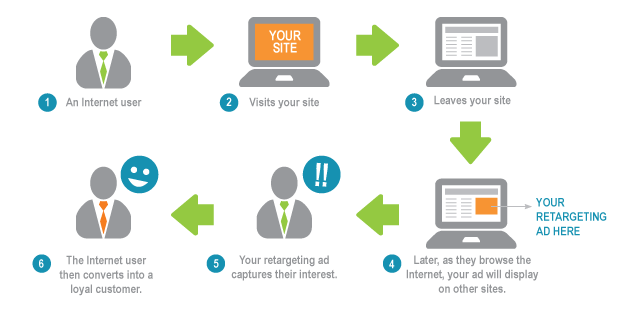It is everyone’s wish to have a successful marketing campaign. Apparently, only a few get to see the desired results from their campaigns. The rest, well, they start preparing for a new marketing campaign.
The new campaign might just be the perfect solution, or wouldn’t it?
How about remarketing? Would remarketing solve their problems?
To a great extent, yes! Especially if they know the remarketing strategies contained in this guide.
What is the meaning of remarketing?
I read a LinkedIn article the other day which sums up the meaning of remarketing, otherwise referred to as retargeting, as a simple marketing tactic that helps you to advertise to people who have visited and shown interest in your product or service. This definition is clearly illustrated by the image below:
 Image credit – LinkedIn
Image credit – LinkedIn
Google understands the benefits of remarketing and listed some of them as:
- Remarketing provides a digital marketer with access to people when they are most likely to buy. This means you have a great opportunity to reach your customers when they are searching for you.
- It provides lists tailored to one’s advertising visions.
- It improves brand recall as it is a great tool for reminding people of your brand while increasing conversion rates.
There are quite a few types/forms of remarketing, namely:
- Site Remarketing
- Email Remarketing
- Social Media Remarketing
- Remarketing Lists for Search Ads (RLSA)
- Search Remarketing
- Engagement targeting
For a successful remarketing campaign, a digital marketer needs to come up with a near perfect fail proof strategy. Apparently, those who have such strategies guard it jealously.
Nevertheless, here are 7 strategies for a successful remarketing campaign.
- Separate Your Audience By Devices: Using statistics from your Google analytics accounts, you should aim at creating a separate remarketing audience based on each device. Thus, you should separate mobile users from desktop users and create separate retargeted ads for them. This is a basic, but yet effective Google RSLA (Remarketing Lists for Search Ads) campaign strategy that ensures returns on your investments.
- Audience Segmentation: People visit websites for various reasons and some leave as soon as they enter the website, possibly down to a poorly designed website. Audience segmentation allows you to create custom messages for different visitors at different stages of the sales funnel, which further allows you to use the data analysed for retargeting purposes.
- Focus on conversion and shopping cart abandons: Many marketers have begun to understand the dreadful need to put ads in front of people who abandoned products in their shopping carts. As soon as they leave your website, it is vital that they begin to see ads related to those products/pages they have viewed on your site. When you tailor your messages here, try to apply the illusion of “almost at the finishing line”, so users know they are about to give up on something with 1 step remaining when they had taken 5 steps before getting to that point.
- Tailor your messages: If your message and its call to action don’t appeal to the person to whom it’s targeted at, what gives you the impression that they are going to visit your website again? Messages on your ads should be:
- Brief, but yet concise and valuable.
- Laced with elements of humor/fact (if possible).
Use novel messages occasionally, compare products in ads using a comparison chart, or a buyer’s guide – anything that would nudge their interest towards making either a bigger or a better commitment.
- Cap the number of time your ads are seen. There’s a saying that “too much of everything is not good” – same applies in remarketing. Capping the number of times your ads are seen simply implies that you should limit the number of times a visitor you’re retargeting sees the ad. If you don’t cap it, chances are that they might get used to seeing the ads and it wouldn’t mean much to them anymore. Always update ads with the same objective, but different images. It is pertinent to note that the frequency cap on a retargeted ad limits the number of impressions the ad gets.
- Manage you placements well. You need to place your ads in front of the right people at the right time and in the right place. Choose the right websites where your ads are displayed on as it will ensure that you don’t waste your resources on websites that would offer you nothing. Facebook is a great place to start a remarketing campaign. A quick tip for Facebook ads; use the carousel format ads – see our social media advertising services.
- Remarketing campaigns should not always be about you: Yes, your aim of creating a remarketing campaign is to drive sales and apparently increase conversions on lost leads, but you’re forgetting that people also like free things. Occasionally, your remarketing campaign should offer free products or limited free trials, and as many meaningful information that you can offer for free – the type that cannot be found elsewhere on the internet. It will help foster a customer-brand trust and value filled relationship.
Now it’s time to get to work. These strategies will improve you marketing effort if well implemented. Here is another post on how to regain lost leads through remarketing.
If there’s a problem you’re facing in your remarketing campaigns, feel free to share it – we’d be glad to help you. Do contact us and one of our experts will be in contact.


